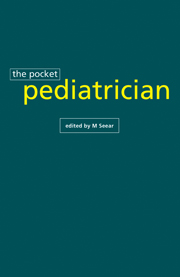Book contents
- Frontmatter
- Contents
- Analytical contents list
- Preface
- 1 Cardiology
- 2 Death and dying
- 3 Emergencies
- 4 Endocrinology
- 5 Fluids and electrolytes
- 6 Gastroenterology
- 7 General surgery
- 8 Health care ethics
- 9 Hematology
- 10 Infectious diseases
- 11 Intensive care and continuous infusion drugs
- 12 Medical genetics
- 13 Neonatology and neonatal drug dosage guidelines
- 14 Neurology
- 15 Nutrition
- 16 Oncology
- 17 Pediatric transport
- 18 Pharmacology and drug dosage guidelines
- 19 Renal
- 20 Resident fellow training
- 21 Respirology
- 22 Rheumatology
- 23 Transfusion medicine
- 24 Appendix
- Index
6 - Gastroenterology
Published online by Cambridge University Press: 01 February 2010
- Frontmatter
- Contents
- Analytical contents list
- Preface
- 1 Cardiology
- 2 Death and dying
- 3 Emergencies
- 4 Endocrinology
- 5 Fluids and electrolytes
- 6 Gastroenterology
- 7 General surgery
- 8 Health care ethics
- 9 Hematology
- 10 Infectious diseases
- 11 Intensive care and continuous infusion drugs
- 12 Medical genetics
- 13 Neonatology and neonatal drug dosage guidelines
- 14 Neurology
- 15 Nutrition
- 16 Oncology
- 17 Pediatric transport
- 18 Pharmacology and drug dosage guidelines
- 19 Renal
- 20 Resident fellow training
- 21 Respirology
- 22 Rheumatology
- 23 Transfusion medicine
- 24 Appendix
- Index
Summary
GASTROINTESTINAL BLEEDING
Definitions
Hematemesis
Refers to emesis of fresh blood (bright red) or old blood (“coffee grounds”; more than 2–3 minutes in gastric contents). It should be distinguished from nasal bleeding and hemoptysis, either of which may be swallowed and vomited or directly spat out. When the source of bleeding is in the Gl tract, it is usually from a site proximal to the ligament of Treitz.
Hematochezia
Refers to the passage of fresh blood per rectum. The source of bleeding is usually in the colon although a large volume upper gastrointestinal (Gl) bleed with rapid intestinal transit may present as hematochezia. In these circumstances, the blood may be bright red or slightly maroon.
Melena
Refers to the passage of shiny, black, tarry stools which are strongly positive on guaiac testing (Hemoccult).
Etiology
Table I classifies the causes of Gl bleeding by age group and site of bleeding. There are several conditions that can mimic Gl bleeding and they should be excluded:
Swallowed blood from nasopharynx or lungs.
Red colored candies, juices and foods.
Black colored (Hemoccult negative) stools: Bismuth (Pepto–Bismol), iron preparations, licorice and blueberries.
Normal color stools, false positive Hemoccult: spinach, meat fibers.
In some conditions, bleeding can be slow or “occult” with no overt bleeding episode. This may present as iron deficiency anemia.
Causes of occult Gl bleeding (many of these disorders also cause overt Gl bleeding):
Inflammatory causes: duodenal ulcer, peptic esophagitis, gastric ulcer, Crohn's disease, ulcerative colitis, eosinophilic gastroenteritis.
Infectious causes: H. pylori duodenal ulcer, H. pylori gastric ulcer, hookworm, strongyloidiasis, ascariasis, tuberculous enterocolitis, amebiasis.
- Type
- Chapter
- Information
- The Pocket PediatricianThe BC Children's Hospital Manual, pp. 67 - 90Publisher: Cambridge University PressPrint publication year: 1996



